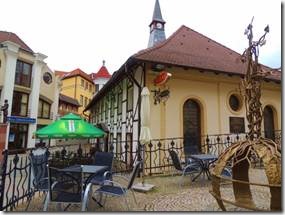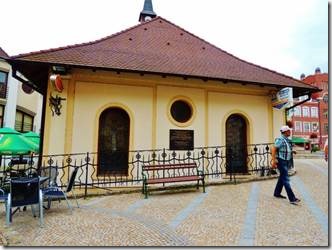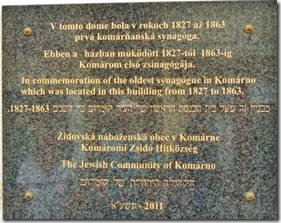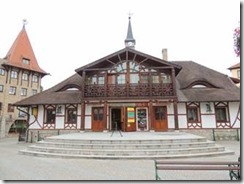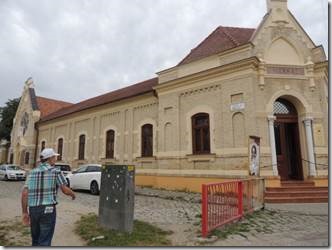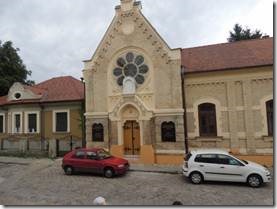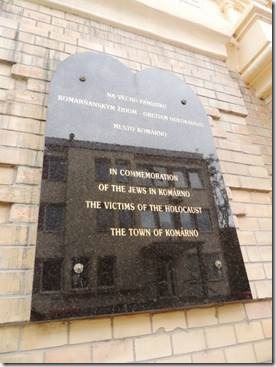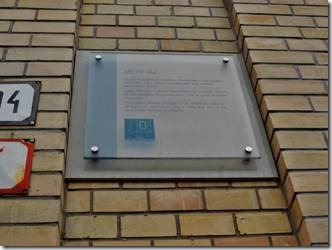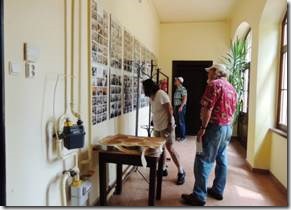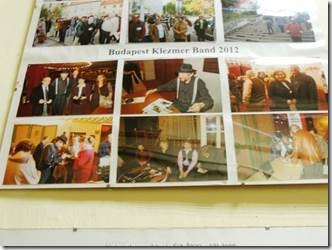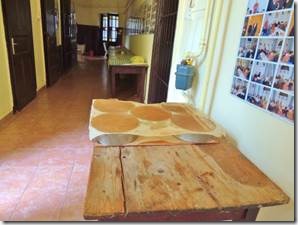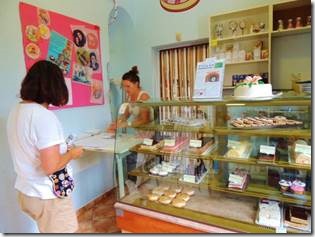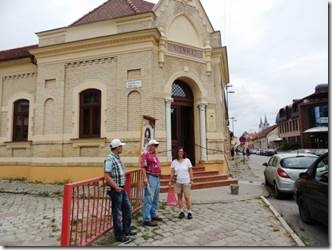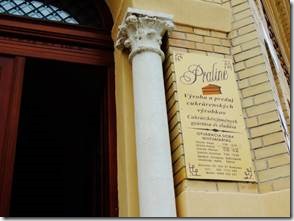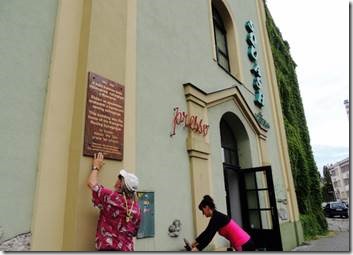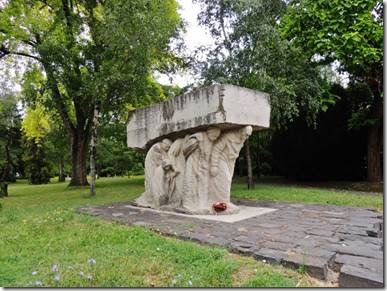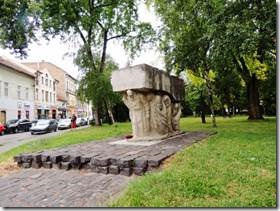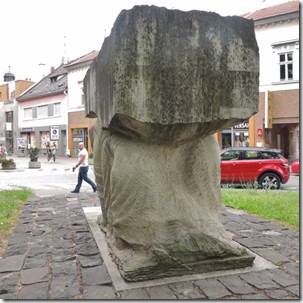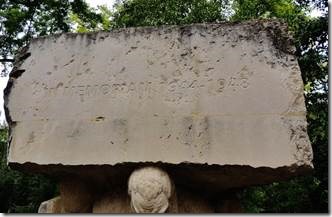Marina Apatin
Здраво or zdravo = hello
We have officially checked out of Hungary and Schengen and are now in Apatin Serbia. We’ll probably be here for one or two nights and then keep moving along. Last night was our final night and we spent it in Mohacs, Hungary.
This email returns us to Komarno, Slovakia. After that I’ll begin a multi post on Budapest. I seem to be learning European history in spite of myself. All so confusing. And a good deal of it sad. But as Tina Turner sang, “If you come down to the River Bet you’re gonna find some people who live You don’t have to worry ’cause you have no money People on the river are happy to give….” Those words from Proud Mary popped into my head as I thought about the people we’ve met along the way. Obviously one does have to have money…marinas cost money….but everyone is always really helpful, warm and welcoming. Happy to have some Americans come visit.
Ru
|
www.slovak-jewish-heritage.org In commemoration of the oldest synagogue in Kpmarno which was located in this building from 1827 to 1863. The Jewish Community of Komarno 2011 |
|
Located in what is being developed as the “Courtyard of Europe” complex the former Orthodox synagogue now houses a souvenir shop as well as a non-Jewish old age home. |
|
Menhaz : “a unique monument comprising the former Jewish old age home and its restored synagogue.” “The Jewish community of Komarno today uses the building of the former Jewish old age home, built in 1896. The compounds refurbished synagogue is a simple hall with original furnishings and impressive neo-Gothic decoration. A Holocaust memorial with a Yizkor book listing the names of the Komarno victims is on the northern wall of the sanctuary. In addition there are two memorial plaques, mounted by the municipality, on the façade. Slovak Jewish Heritage Route brochure that I received at the town tourist office. There was a second plaque on the façade but it was in Slovakian and Hebrew. The blue and white plaque tells that the building had been the old age home. |
|
The synagogue wasn’t open the day we were in Komarno, but the building, which houses a bakery, was opened so we went inside and looked at the photo boards. This one showed photos of a Klezmer band, but one photo was a reunion of Auschwitz survivors or families connected with victims. |
|
Cakes were cooling in the hallway. We bought some pastries to enjoy and as a thank you for letting us wander around. I didn’t have any ( sugar is bad for cholesterol ) but Mary said they were quite good. Standing outside the bakery entrance |
|
Around the block from the Synagogue was this building with a sign that read..” 1863 – 1944 This building was the home of the Komarno Neolog Synagogue.” The plaque was placed there in 2010 by The Jewish Community of Komarno |
|
“Limestone sculpture depicting several people under a heavy burden. The monument is both a memorial to the Hungarians executed during the public administration in southern Slovakia in 1945-48 and the deportations under the administration of the Communists after 1948” •Péter Gáspár (1951), Slovak sculptor. http://www.vanderkrogt.net/statues/object.php?webpage=ST&record=skni030 The dates intrigued me as it’s after the war as well as during the war. But I can’t find any information about the sculpture other than what I posted. |
More then a double trouble- Komarno community in Slovakia
Ian Shulman/ Austria
February 15, 2012 | 8:04 am
Tamas Paszternak
I was aware from the very beginning that my first stop in Slovakia is not going to amaze me by its architectural or landscape beauty. However, I knew beforehand that it is going to be something special due to certain fascinating geographical, national and linguistic reasons. If only I’d have remembered the main factor, which can make any god forsaken place special. The human factor.
The town of Komarno was a must see. It lies on the magnificent Danube, which is a natural border between Slovakia and Hungary. In addition to that, the town is equally (around 100km) away from the capitals of both states – Bratislava and Budapest. But despite of the great location, which turned Komarno into an important military and trade port some centuries ago, the city’s 35,000 population is rapidly declining. 40 of those people are members of local Jewish community. It may seem to be a miserable particle of the famous community which the city hosted before the WWII, but would you think that it almost doubled during the last 15 years?
Tamas Paszternak, the leader of Komarno’s community, knows how hard it is to attract new people to a small town in one of the poorest regions of one of the poorest European countries. Even trying to retain the current residents is already a challenge – Tamas himself lives in Budapest. Is a good old word ‘duty’ able to describe the strange force which makes Tamas put all his efforts on sustaining and developing this community? He started with a simple rule – at least one event per month needs to be organized in a former community building, which the community managed to reclaim from the state in the 1990s. Be it a major Jewish holiday, a klezmer concert, an art exhibition or a lecture – one event per month is just like a pulse of the community, a monthly confirmation of its existence. The signal was received and accepted. Today the Jewish center on Eötvösova street attracts dozens of people, many of which come from outside of the community – simply because this organization became probably the most vibrant place of the town.
But Paszternak goes further. Newly restored synagogue, the only monthly Jewish community magazine in Slovakia with 400 printed and numerous e-mailed copies, different activities for all age groups, assistance in roots search – this is only a part of what the community has achieved now. However, not everything goes that smooth. While the involvement of non-Jewish population is high, a certain degree of hostility is still there, claims Tamas. Thus, while some high schools invite him to teach about the history of Jews in Komarno, universities are not willing to have any Jewish-related input to their history course programs. Paszternak’s attempts to prevent a Hungarian Neo-Nazi band from performing in the town was unsuccessful too. But it seems that for this person there is no aim which is too high, there are only aims which he has to reach.
“Being a Hungarian-speaking Jew in Slovakia is not even a double trouble” – smiles Tamas. I remembered these words while walking the empty streets of Komarno’s cozy old town towards the station, hoping deep inside that the freezing wind is the only reason why I hardly met a person in this town. The oddly-yellow building of the town hall, arty-crafty newly-built Europa square with its pretentiously pan-European buildings, the ruins of medieval Komarno fortress, which used to host Soviet barracks, dull docklands, beautiful Danube, and this wind, which can spoil the impression of any city. Is this ‘triple trouble’, is this ruin actually the force which made this man dedicate all his life to the tough mission of revival, which results can only be visible locally, since 100 km is way too far and numbers of 35,000 and 40 are way to small? Is this actually a revival? And will this revival go on?

